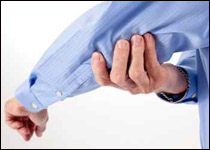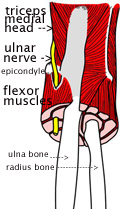
 Cubital tunnel symptoms include inner elbow pain, and pain, tingling, numbness, burning, and weakness down the ulnar forearm and hand to the pinkie and ring fingers.
Cubital tunnel symptoms include inner elbow pain, and pain, tingling, numbness, burning, and weakness down the ulnar forearm and hand to the pinkie and ring fingers.
The cubital tunnel is at the inner elbow (medial epicondyle) formed by the dog bone knob of the upper arm bone (humerus). The ulnar nerve goes around it like a pully as it travels into the forearm to innervate the 4th and 5th digits. The tunnel is the space between the epicondyle and the middle tip of the elbow (olecranon process). Two things can happen in this tunnel. One is that the nerve can become irritated by rubbing against the bone. The other is that it can be trapped by muscles, producing similar symptoms. The first situation can sometimes be treated medically by surgically removing extra bone or opening up the connective tissue space for the nerve to travel more easily.
In my Neuromuscular Therapy center near Boston I treat cubital tunnel syndrome by treating the muscles, especially the triceps muscle above and the flexors of the wrist and fingers below the elbow. The nerve can become trapped there 1) by an arch of connective tissue or 2) by taut bands from Trigger Points in the muscles or 3) by being compressed as it travels between them. Trigger Points can develop in the muscles when the nerve that serves them gets irritated. They can also form when those muscles are overused in forceful gripping motions, from sustained gripping combined with wrist flexion as when driving long, distances and from repeatedly bending the elbow like doing biceps curls or using a hammer.
The triceps are important to treat for two reasons. The first is that the triceps bend (flex) the elbow. If the nerve is irritated, repeated flexion can irritate it more especially if the triceps are tight. Secondly, the three-headed muscle has Trigger Points in two of its heads that refer pain into the 4th and 5th fingers.
If medical conditions causing ulnar neuropathy have been corrected, creating space for the nerve and releasing Trigger Points causing cubital tunnel syndrome symptoms eventually will stop the pain. Home treatments include icing to reduce inflammation, specific stretching without bending the elbow and manual treatment of the muscles above and below the epicondyle.
Look for self-treatment notes in a future post. Next is a discussion of tennis elbow.